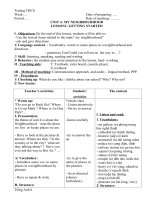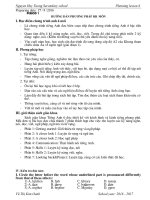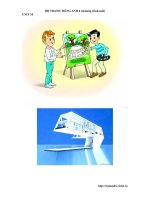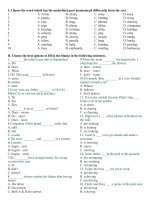unit 4 anh 6 thi diem
Bạn đang xem bản rút gọn của tài liệu. Xem và tải ngay bản đầy đủ của tài liệu tại đây (731.8 KB, 15 trang )
<span class='text_page_counter'>(1)</span>period 26 UNIT4 Lesson 1. MY NEIGHBOURHOOD. Getting started Lost in the old town. I. Teaching points: By the end of the lesson, Ss can .know some vocabulary about places, derections .use suguestions . read for specific information about good things in the neighbourhood . talk about different places and show directions to these in a neighbourhood. +Teaching aids: Poster, CD record &cassettes, pictures. II. Teaching steps. Teacher and Students' activities Contents and Board I. Warm up: - look through the picture and remember Kim's game ( 2 groups) some things in it. Pre - teach -Teacher sets the scene by asking Ss about the picture Where are Nick , Khang and Phong? What might be happening to them? What are they doing? -Have you ever got lost? Where and when? How did you feel then? What did you do? - Elicits the new words using pictures and explaination + Check vocabulary : R O R. II. New lesson. A. Getting Started. 1. Vocabulary: - excited (a): phấn chấn, khích ứng - exciting (a): thú vị, hứng thú, kích ứng - historic (a): cổ kín,cổ - lost (a): lạc, bị lạc - memorial (n): Đài tưởng niệm - cathedral (n) : Nhà thờ lớn. -Play the recording. Ss listen and read.Pause the recording at the appropriate 2. Listen and read: places if Ss need with comprehension questions..
<span class='text_page_counter'>(2)</span> -Ss work independently. Allow them to share answers before discussing as a class. - Tell Ss to refer back to the conversation to find the phrases. Practice saying them together( play the recording again as a model if necessary). _ First, model the role- play with a more able St. Then ask pairs to role- play the short conversations before demonstrating the class.. 1a: Read and put the actions in order KEY: 2 5 3 4 1 6 1b: Making suggestions. Put the words in the correcct order. KEY: 1.a.Where shall we go first? b. Let's go to " Chua cau" 2.a. Shall we go by bicycle? b. Ok, sure. 3.a.Shall we go by bicycle? b. No, let's walk there. Form: Shall we vinf.... Let's Practice:2 Role play making suggestions: ( Ex: SGK). 3. Match the places below with the pictures. Then listen, check and repeat the works. -Ss work in groups.Ss match the picture 1 E- Square: Quảng trường with the places 2H -palace: Cung điện - Correct. 3 F -cathedral: Nhà thờ lớn 4C -memorial: Đài tưởng niệm 5 G- art gallery: Triển lãm tranh 6 A- statue: Tượng 7 B -railway station: Ga tàu 8D- temple: Miếu thờ -First, model this activities with a more 4. Think about where you live able Ss. Ask Ss to work in pairs. Call some Ex: A: Is there a theatre in your pairs to practise in front of the class. neighbourhood? _ Have Ss quickly match each instruction with the diagram. Check their answer. Translation ( weak student) Ask some additional questions( strong Students). - Demonstrate the game to the class first. Ask a more able S to help. Then Ss play in pairs. B: Yes, There is/ No, There isn't 5. Match the instructions in the box with the pictures. 1. Go straing on. 2.turn left at traffic lights. 3. Go past the bus stop. 4.Take the first turning on the left./Take the first left. 5.Go to the end of the roard. 6 Go along the street. 7 Cross the street. 6. Game : Give your partner directions to one of the places on the map, guess then swap EX; A : Go straight. Take the second turning on theleft. It's on your right..
<span class='text_page_counter'>(3)</span> B: Is that the art gallery? A: Yes,it is/ No, try again -Sumarize and review the lesson. -Prepare closer look 1.. III. Home work. Learn the new words -Review the lesson. -Prepare closer look 1.. period 27 UNIT4. MY NEIGHBOURHOOD. Lesson 2. Closer look1. I. Teaching points: By the end of the lesson, Ss can By the end of the lesson, Ss can: - use vocabulary and structures about people and places ( adjectives opposite) - pronounce 2 sounds: /i:/ and /i/ . +Teaching aids: Poster, CD record &cassettes, pictures. II. Teaching steps. Teacher and Students' activities Contents and Board I. Warm up: - Decribe the pictures using adjectives 2 groups: Write the words as much as possible. II. New lesson. A. Vocabulary. - Elicits the new words using pictures and - narrow(a): hẹp explaination - Fantastic : tuyệt vời, tuyệt diệu - convenient: tiện lợi - polluted: bị ô nhiểm -peaceful:yên bình, thanh bình + Check vocabulary : practice saying the adjectives with Ss. Then ask Ss to write the 1. Fill in each blank with one word correct adjectives in the blanks. Play the from the box. Listen then check, repeat record as many times as reqired to allow them to check their answers , support their the words. pronunciation. 2. convenient 3.boring 4.polluted. 5. historic 6.narrow 7. noisy - Explain the contents in " Watch out!" carefully to the Ss. T may take some more examples to illustrate. Ask Ss to do the vocabulary exercise individually. Check with the whole class. When checking, ask Ss to refer to 1 to make the meanings of. 2. " Watch Out": Sometimes words can have two or more opposites: noisyquiet/ peaceful. some words don't have opposite : polluted KEY: boring-exciting; historic-modern.
<span class='text_page_counter'>(4)</span> noisyquiet/peaceful. convenientinconvenient; fantastic-terrible.. the opposites clearer to them. First model this activity with a more able S. Remind Ss that they only use the adjectives they have learnt in 1 and 2 to talk about their village, town or city.Then Ss works in pairs. Call some pairs to practise in front of class.. - T asks some Ss to read out the words first , then plays the recording for them to listen and repeat the words. - Ss listen and distinguish /i:/ and /i/. - T asks Ss to circle the words while they listen . - Ss compare their answers in pairs before T checks their answers with the whole class -Play the recording. Ss listen and repeat sentence by sentence. Help them to recognize the sounds and the rhythm. -Ss practise the chant by dividing the class into two groups. Have groups sing alternate lines -Summarize the main points of the lesson... 3.Work in pair....... Ex: A: Is your neighbourhood polluted? B: No, it isn't A: Is it peaceful? B: Yes, it is. B. Pronuciation /i:/ and /i/ 4. Listen and repeat. exciting cheap historic sleepy expensive convenient peaceful police noisy friendly /i:/ cheap sleep peaceful convenient police. 5. Listen then circle the words you hear. Key. 1. living 7. teams 2. heat 8. chip 3. seats 4. sheep 5. tins 6. mill 6. Listen and repeat the chant. Notice the sounds /i:/ and /i/.. III. Home work. Learn the new words -Review the lesson. -Prepare closer look 2.. period 28 UNIT4. MY NEIGHBOURHOOD. Lesson 3. Closer look2. I. Teaching points:. /i/ historic exciting expensive noisy friendly.
<span class='text_page_counter'>(5)</span> By the end of the lesson, Ss can focus on comparative adjective forms +Teaching aids: Poster, CD record &cassettes, pictures. II. Teaching steps. Teacher and Students' activities Contents and Board I. Warm up: - Decribe the pictures using adjectives 2 groups: Write the words as much as possible. II. New lesson. T introduces the subject of the lesson : A. Grammar comparative adjectives and give the rule. * Short adjectives: one or two syllable(s) S1 + V + adj + er than + S2 ( fast- faster; large- larger; noisy- noisier; hot- hotter) * Long adjectives: two, three or more syllables S1 + V + more adj + than + S2 ( modern- more modern; expensive- more expensive...) REMEMBER;: Irregular adjectives - good/ well better bad worse - many / much more little less - far farther / further B.Practice: 1. Complete the following sentences with the comparative form of the Ask Ss to read the instructions. Tell Ss what they should do. Then have Ss compair adjectives in th brackets. their answers in pairs before checking with KEY: 2. taller 3. bigger 4. noisier the whole class. 5.cheaper Ask Ss to read the instructions. Use the 2 Now complete the following sentences example to show ss what should do. Then with the comparative form of the long have Ss compair their answers in pairs adjectives in brackets before checking with the whole class. KEY: 2 more beautiful 3. more convinient 4. more interesting 5 more - Ask Ss to read and complete the expensive. sentences individually. remind them to pay attention to the number of the syllables in 3. Read and complete Vy's letter to her each adjective. Compare their answers in pairs before checking with the whole class. friend. KEY: 1 drier 2 smaller 3 older 4 wider - T elitcits . Write sentences compare the.
<span class='text_page_counter'>(6)</span> two the neighbourhood. Compare in pairs .then saying to the whole class. - Feedback.. Ask Ss to read the instructions. Use the example to show ss what should do. Then have Ss compair their answers in pairs before checking with the whole class -First model this activity with a more able S. Remind Ss that they only use the information they have written in 4 to ask and answer questions about the two neighbourhood.Then Ss works in pairs. Call some pairs to practise in front of class. - Ask Ss think of the places that they've been to.Model this activity with a more able St.Then Ss works in pairs. T goes around the class and monitors. Ask a few pairs with the most imaginative ideas to report them to the class.. -Summarize the main points of the lesson... period 28 UNIT4 Lesson 4. 5 more delicious 6 cheaper 4. Look at the pictures of Yen Binh neighbourhood and LangSon neighbourhood . Now write about the differences. Ex: Yen Binh is more crowed than Lang Son. 5.Complete the following sentences with the comparative form of the adjectives in brackets KEY: 2 more expensive 3 more comfortable 4 more historic 5 narrower 6.Work in pairs. ..... EX: A: Is Yen Binh more crowded than Lang Son? B: Yes, It is A: Is Lang Son more modern than Yen Binh? B: No, it isn't. 7. Work in pairs. Ask and answer the places that you know... Ex: Is Hue busier than Da Nang? No , it isn't III. Home work. Learn the new words -Review the lesson. -Prepare comunication.. MY NEIGHBOURHOOD. Comunication. I. Teaching points: By the end of the lesson, Ss can : - Listen for specific information about directions to some places in a neighbourhood. - Talk about different places, use connective words and some expressions to give directions to these places in the neighbourhood..
<span class='text_page_counter'>(7)</span> +Teaching aids: Poster, pictures. II. Teaching steps. Teacher and Students' activities T: Show pictures to teach new words. Ss: Have a look at the pictures and guess the meanings of thhe new words. -Ask Ss to write anything they know about Hoi An.. Contents and Board I. Warm up: Brainstorming Cao lầu Many old houses. Hoi An. Chùa Cầu World heritage An ancient town II. New lesson.. - give some new words.. * Vocabulary checking : R.O.R. 1/ New words: - first : trước tiên - then : tiếp theo , rồi thì… - after that : sau đó - finally : cuối cùng - to guide : hướng dẫn - be famous for : nỗi tiếng về - direction (n): phương hướng - Sa Huynh Culture : nền văn hóa Sa Huỳnh. Play the recording. First, ask Ss to listen 2/ Act1: Listen and fill in the gaps. only. - Play the recording again and allow Ss to 1. historic 2. covenient 3 straight 4 second 5.left 6 right 7 second 8 next to. fill in the gaps as they listen. - Ask Ss to share their answers in pairs, before playing the recording a final time to allow the pairs to check their answers..
<span class='text_page_counter'>(8)</span> - Ask Ss to read the audio guide again, paying attention to the use of the connective words: first(ly), second(ly), then and finally Ask Ss to read the brief information about London and Ho Chi Minh City and look carefully at the two simplified maps of the two cities. - Elicit additional information about the two cities from Ss, then ask Ss to read the - Ask Ss some more questions to check if they know what they are supposed to do. - Remind Ss of the expressions they can use to give directions. ( Ss may refer to the expressions in the dialogue and exercise 5 of Getting started.) - Have Ss prepare their audio guide individually and then share it with apartner. - Ask Ss to practice presenting their audio guide in pairs or in groups.. 3/Act 2: Create an audio guide for a city. instructions carefully.. Ho Chi Minh City. London - Elicit information about Da Nang from Ss. - Ask Ss to prepare their audio guide individually and then share it with partner.. - Have Ss present their audio guide to the class.. 4/ Act 3:Create an audio guide for Da Nang City. Give the city fact file : Da Nang City: one of the largest cities in VN; on the river Han, Ngu Hanh Son Mountains, wide and clean streets, many beautiful beaches and bridges..
<span class='text_page_counter'>(9)</span> -Summarize the main points of the lesson... period 29 UNIT4 Lesson 5. III. Home work. Learn the new words - Write the audio guide into your notebook. -Review the lesson. -Prepare skill 1.. MY NEIGHBOURHOOD. Skill 1. I. Teaching points: By the end of the lesson, Ss can : - read a blog for specific information about good things and bad things in a neighbourhood. - ask and answer questions about the way to get to the places . - +Teaching aids: Poster, pictures. II. Teaching steps. Teacher and Students' activities - T asks Ss: Where do you think Khang’s neighbourhood is?. Contents and Board I. warm up Ss look at the picture of Khang’s neighbourhood. Answer individually'. What do you think about it? Do you like living there? Why? Why not? - T asks Ss to scan the blog to find these words in the pasage.. II. New lesson. - T may help Ss find out the meaning of the words in the context.. 1. Vocabulary:. A. Reading:.
<span class='text_page_counter'>(10)</span> Suburb (n):. ngoại ô. Backyard (n):. sân sau. Incredibly (adj): vô cùng, thật ngạc nhiên T asks Ss to read the text again and answer the questions.. Beach (n):. bãi biển. (to) dislike:. không thích. -T asks Ss to note where they found the information that helped them to answer the 2. Anwer the questions: questions. * Key: -Ss can compare their answers with their partners. 1/ It is in the surburbs of Da Nang -T corrects the answers:. 2/ Because it has beautiful parks and sandy beaches and fine weather. 3/ They are very friendly.. _ Ss scan the passage again and find the information to complete the table.. 4/ Because there’re many modern buildings and offices in the city.. _ Ss note where they found the information and compare with their partners.. 3/ Fill in the table with the information:. _ Feedback: 2Ss write on the board.. Like - It’s great for outdoor activities.. _ T checks and corrects it. - There’s almost everything here. - Most houses have a backyard and a frontyard. - People are incredibly friendly. - The food is very good. B. Speaking: 4/ Look at the map of Khang’s neighbourhood and give directions:.
<span class='text_page_counter'>(11)</span> T reviews the expressions they can use to give directions.. Directions: 1. Go straight on 2. Turn left ... 3. Go past… 4. Take the first 5. Go to the end 6. Go along 7. Cross. T asks Ss to work in pairs, asking and answering questions about the locations on the map. T: Can you tell us the way to the market? -T may model this activity with a good student. T calls some pairs to talk before the class S1: First, go along Cu Chinh Lan street. Then take the second turning on the left. -Ss work in pairs to practice the dialogue.. After that go straight . It’s on your left.. -T selects some good pairs to act out their dialogues in front of the class.. 5/ Ask and answer questions about the way to get to the places in your city. -. Summarize the main point of the lesson. -Assign home work.. Homework: -Practice reading comprehension a blog. Review the lesson. -Prepare skill 2.. PERIOD 31. UNIT4. Lesson 6:. MY NEIGHBOURHOOD. Skill 2: listening - writing.
<span class='text_page_counter'>(12)</span> P: T: I. Teaching points: - Listening to understand the conversation between a stranger and Duy' Dad - Writing a paragraph about what SS like or dislike their neighbour hood. * Teaching aids: -Posters, cassette. II. Teaching steps. Teacher & Ss - Ss work in 2 teams. - Check and correct. Board & contents A. WARM-UP: Network “Decribe your neighbourhood". B. NEW LESSON I. Listening. Pre 1. Vocabulary -Present some new words. super market: siêu thị cafe': cà phê secondary school: trường cấp 2 lower secondary school : trường cấp 1 sandy: có cát -Ask Ss to read the dialogue and guess the office: văn phòng, cơ quan missing words.(EX1) Ask Ss to read the rubric and study te map 2. Prediction. (Ex1) carefully. Pair work to discuss how to get the places mumbered 1-4 from the You are here point.( Ex2) While -Play the recording for checking and completing the missing words in the dialogue. -Play the recording twice. - Ss listen choose the correct answers. Share their ideas together. - Play the recording the final time then check their answers.. 3. Check the prediction. (Ex1) 1. the end 2 right 3.lower secondary school 4. Le Duan street 5.secondary school EX2.Choose the correct places 1.A 2C 3F 4D. -Ask Ss tick what they like or don't like about a neighbourhood.. II. Writing. 1.Pre:EX3. Tick (V) what you like or don't like about a neighbourhood. 1. sandy beaches.
<span class='text_page_counter'>(13)</span> -Hang the poster on the board. - Share their answers with partners -Ask Ss make notes on what they like or dislike about living in their neighbourhood.Ask them not to write full sentences and they can use abbreviations Share with their partners. T may read out the notes from some more able Ss to the whole class. - Set up the writing activity.Use their ideas they have made in 4. Ask Ss to brainstorm for language necessary for writing. ? Write the first draft.then have them write their final version. - Go around and Correct some T display all or some of the leaflets on the wall/ notice board. Other Ss and T comments.. -Summarize the main point of the lesson. -Assign home work.. PERIOD 32. UNIT4 Lesson 7. 2.heavy tracffice...... 8. many shops, and markets 2. Practice. * Activity 4. Make notes about your neighbourhood, think about the things you like or dislike about it Like Dislike. * Act 5: Write a paragragh about your neighbourhood saying what you like or dis like about living there. Use the information in 4, and Khang'blog as a model. I'd like to tell you some good things and some bad things about living in my neighbourhood.. C. HOMEWORK -SS edit and revise their writing as homework. Write the final version at home. --Prepare new lesson: Looking back.. MY NEIGHBOURHOOD Looking back + Project P: T:. I. Teaching points: - By the end of the lesson, Ss will be able to review name of places and adjectives and their opposites and the grammar points: comparative form of the adjectives. - They also comunicate using suggestions and and create an audio guide. - Write a description of their ideal neighbourhood..
<span class='text_page_counter'>(14)</span> * Teaching aids: poster, cassette. II. Teaching steps Teacher and Students' activities. Contents and Board I. WARM-UP. Group of four -Decribe in your neighbourhood II. NEW LESSON: A Vocabulary: - Tell Ss to write the words in their notebooks 1. Activity 1: Write the correct for each individually and then check with thier picture. partners. then correct the mistakes. Let them KEY 1. Statue 2.Railway station 3. park repeat the words. Check their 4 temple 5. memorial 6 cathedral. pronounciation. 2. Activity 2 _ Ask Ss read the sentences carefully and KEY complete them with the adjectives they have 1. noisy 2 narrow 3 historic 4 incovenient learnt in Unit 4. Remind them that the 5. cheaper/ more expensive. words, phrases and sentences before and after the blands will provide the context for them to choose the correct adjectives.. -For these ex, ask Ss to do them individually first. then they can check their answers with a partner before discussing the answers as a class. However, tell Ss to keep a record of their original answers so they can use that information in their Now you can......statements. -T elicits the language being practiced in this activity. -Ss read the questions and answer once or. B. Grammar Activity 3 KEY one syllabe 2 syllabes fast happy hot noisy large quiet heavy. 3 syllabes exciting expensive convenient difficult polluted. Activity 4 KEY adj comparative form fast faster convenient more convenient noisy noisier difficult more difficult heavy heavier expensive more expensive happy happier hot hotter polluted more polluted exciting more exciting large larger quiet quieter Activity 5 KEY 1 noisier than 2 more modern than.
<span class='text_page_counter'>(15)</span> twice( they read them aloud). Then match them. If there is time, have them write their notebooks.. 3 more convenient than 4 more beautiful than 5 more expensive than. - Ss work in pair and role play the questions and answers . . Finished! Finally ask ss to complete the self C. Communication assesment. Identify any difficulties and weak :*Activity 6. areas and provide further practice. KEY: a-c d-e f-g h-b :*Activity 7. Finished! Now you can.. . name places . give directions .use adjective to describe places. .compare things -T ask ss look at the picture of two neighbourhoods in ss' book, point out the tipical features of them. - SS work in groups to discuss their ideal neighbourhood, using the pictures and their imagination.( if have time). D. Project What is your ideal neighbourhood? 1.Find a photo or draw a picture of your neighbourhood. 2. write a description of it. - where it is - what it has - how the people/ the streets/ the weather..is/ are - other.... -Summarize the main point of the lesson. -Assign home work.. III. HOMEWORK. -Learn the new words. -Compare about some things in your school. -Make a description..
<span class='text_page_counter'>(16)</span>









